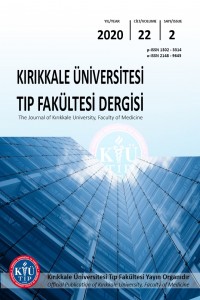DOES THE RESTING TIME AFTER EMERGENCY SPLENECTOMY AFFECT THE FREQUENCY OF POST-SPLENECTOMY INFECTIONS?
Öz
Anahtar Kelimeler
emergency splenectomy opsi postsplenectomy sepsis post-splenectomy infection sick leave
Kaynakça
- 1. Weledji, Elroy P. Benefits and risks of splenectomy. Int J Surg. 2014;12(2):113-9.
- 2. King H. Susceptibility to infection after splenectomy performed in infancy. Ann Surg. 1952;136:239-42.
- 3. Traub A, Giebink GS, Smith C, Kuni CC, Brekke ML, Edlund D et al. Splenic reticuloendothelial function after splenectomy, spleen repair and spleen autotransplantation. N Engl J Med. 1987;317(25):1559-64.
- 4. Rosse WF. The spleen as a filter. N Engl J Med. 1987;17(11):704-6.
- 5. Hosea SW, Brown EJ, Hamburger MI, Frank MM. Opsonic requirements for intravascular clearance after splenectomy. N Engl J Med. 1981;304(5):245-50.
- 6. Thomsen RW, Schoonen WM, Farkas DK, Riis A, Jacobsen J, Fryzek JP et al. Risk for hospital contact with infection in patients with splenectomy: a population-based cohort study. Ann Intern Med. 2009;151(8):546-55.
- 7. Shute PG. Splenectomy and susceptibility to malaria and babesiae infection. Br Med J. 1975;1(5956):516.
- 8. Teo KG, Anavekar NS, Yazdabadi A, Ricketts S. Asplenic fulminant sepsis secondary to a dog bite complicated by toxic epidermal necrolysis/Stevemse Johnson syndrome. N Z Med J. 2012;125(1358):74-7.
- 9. Barmparas G, Lamb AW, Lee D, Nguyen B, Eng J, Bloom MB et al. Postoperative infection risk after splenectomy: A prospective cohort study. Int J Surg. 2015;17:10-4.
- 10. Hansen K, Singer DB. Asplenic-hyposplenic overwhelming sepsis: postsplenectomy sepsis revisited. Pediatr Dev Pathol. 2001;4(2):105-21.
- 11. Dragomir M, Petrescu DGE, Manga GE, Călin GA, Vasilescu C. Patients After Splenectomy: Old risks and new perspectives. Chirurgia (Bucur). 2016;111(5):393-9.
- 12. Sinwar PD. Overwhelming post splenectomy infection syndrome-review study. Int J Surg. 2014;12(12):1314-6.
- 13. Skattum J, Naess PA, Gaarder C. Non-operative management and immune function after splenic injury. Br J Surg. 2012;99 Suppl 1:59-65.
- 14. Bisharat N, Omari H, Lavi I, Raz R. Risk of infection and death among post-splenectomy patients. J Infect. 2001;43(3):182-6.
- 15. Rubin LG, Levin MJ, Ljungman P, Davies EG, Avery R, Tomblyn M et al. 2013 IDSA clinical practice guideline fo vaccination of the immunocompromised host. Clin Infect Dis. 2014;58(3):309-18.
- 16. Schwarzmann SW, Adler JL, Sullivan RJJ, Marine WM. Bacterial pneumonia during the Hong Kong influenza epidemic of 1968-1969. Arch Intern Med. 1971;127(6):1037-41.
- 17. Wong KK, Jain S, Blanton L, Dhara R, Brammer L, Fry AM, Finelli L. Influenza-associated pediatric deaths in the United States, 2004-2012. Pediatrics. 2013;132(5):796-804.
Öz
Anahtar Kelimeler
acil splenektomi opsi postsplenektomi sepsis istirahat post-splenektomi enfeksiyon
Kaynakça
- 1. Weledji, Elroy P. Benefits and risks of splenectomy. Int J Surg. 2014;12(2):113-9.
- 2. King H. Susceptibility to infection after splenectomy performed in infancy. Ann Surg. 1952;136:239-42.
- 3. Traub A, Giebink GS, Smith C, Kuni CC, Brekke ML, Edlund D et al. Splenic reticuloendothelial function after splenectomy, spleen repair and spleen autotransplantation. N Engl J Med. 1987;317(25):1559-64.
- 4. Rosse WF. The spleen as a filter. N Engl J Med. 1987;17(11):704-6.
- 5. Hosea SW, Brown EJ, Hamburger MI, Frank MM. Opsonic requirements for intravascular clearance after splenectomy. N Engl J Med. 1981;304(5):245-50.
- 6. Thomsen RW, Schoonen WM, Farkas DK, Riis A, Jacobsen J, Fryzek JP et al. Risk for hospital contact with infection in patients with splenectomy: a population-based cohort study. Ann Intern Med. 2009;151(8):546-55.
- 7. Shute PG. Splenectomy and susceptibility to malaria and babesiae infection. Br Med J. 1975;1(5956):516.
- 8. Teo KG, Anavekar NS, Yazdabadi A, Ricketts S. Asplenic fulminant sepsis secondary to a dog bite complicated by toxic epidermal necrolysis/Stevemse Johnson syndrome. N Z Med J. 2012;125(1358):74-7.
- 9. Barmparas G, Lamb AW, Lee D, Nguyen B, Eng J, Bloom MB et al. Postoperative infection risk after splenectomy: A prospective cohort study. Int J Surg. 2015;17:10-4.
- 10. Hansen K, Singer DB. Asplenic-hyposplenic overwhelming sepsis: postsplenectomy sepsis revisited. Pediatr Dev Pathol. 2001;4(2):105-21.
- 11. Dragomir M, Petrescu DGE, Manga GE, Călin GA, Vasilescu C. Patients After Splenectomy: Old risks and new perspectives. Chirurgia (Bucur). 2016;111(5):393-9.
- 12. Sinwar PD. Overwhelming post splenectomy infection syndrome-review study. Int J Surg. 2014;12(12):1314-6.
- 13. Skattum J, Naess PA, Gaarder C. Non-operative management and immune function after splenic injury. Br J Surg. 2012;99 Suppl 1:59-65.
- 14. Bisharat N, Omari H, Lavi I, Raz R. Risk of infection and death among post-splenectomy patients. J Infect. 2001;43(3):182-6.
- 15. Rubin LG, Levin MJ, Ljungman P, Davies EG, Avery R, Tomblyn M et al. 2013 IDSA clinical practice guideline fo vaccination of the immunocompromised host. Clin Infect Dis. 2014;58(3):309-18.
- 16. Schwarzmann SW, Adler JL, Sullivan RJJ, Marine WM. Bacterial pneumonia during the Hong Kong influenza epidemic of 1968-1969. Arch Intern Med. 1971;127(6):1037-41.
- 17. Wong KK, Jain S, Blanton L, Dhara R, Brammer L, Fry AM, Finelli L. Influenza-associated pediatric deaths in the United States, 2004-2012. Pediatrics. 2013;132(5):796-804.
Ayrıntılar
| Birincil Dil | İngilizce |
|---|---|
| Konular | Sağlık Kurumları Yönetimi |
| Bölüm | Makaleler |
| Yazarlar | |
| Yayımlanma Tarihi | 31 Ağustos 2020 |
| Gönderilme Tarihi | 18 Temmuz 2019 |
| Yayımlandığı Sayı | Yıl 2020 Cilt: 22 Sayı: 2 |
Kaynak Göster
Bu Dergi, Kırıkkale Üniversitesi Tıp Fakültesi Yayınıdır.


